Running is more than just fast walking. It’s a rhythm. A pattern. A full-body motion that, when done well, feels effortless — like your body is flowing forward with each stride. But for runners who are amputees or use prosthetic limbs, this rhythm can feel off. The body tries to find balance, speed, and power all at once, but not every part may be in sync.
That’s where sports-specific gait training comes in. It’s not just about learning to walk or run — it’s about training your body to move with purpose, precision, and control. It’s about teaching every muscle, joint, and part of your prosthesis to work together like a team. When done right, it helps runners build better form, reduce injury, and feel confident in every stride, whether they’re sprinting on the track or pacing through a marathon.
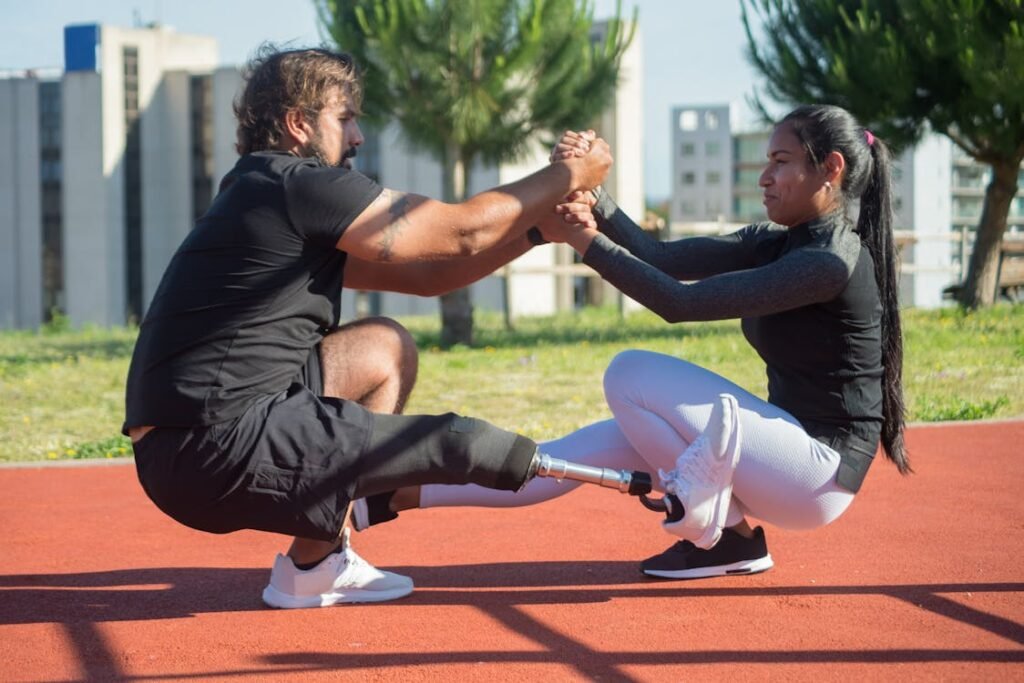
Understanding Gait Training for Athletic Movement
Why Running Is Different from Walking
Walking is about stability. Each foot touches the ground before the other one lifts. Your body shifts slowly from side to side, with time to balance. But running is more like controlled falling — there’s a moment when both feet are off the ground. That floating moment takes power, timing, and coordination. Your muscles must push harder, your arms swing with purpose, and your core tightens to keep everything steady mid-air.
For an active amputee, especially one using a prosthesis, this adds a layer of challenge. The body naturally tries to protect itself. It may avoid putting full weight on the prosthetic limb or shorten the stride to prevent discomfort. This creates an uneven pattern. Over time, this imbalance can lead to pain, fatigue, or injury.
Sports-specific gait training helps fix these imbalances. It focuses on running, not walking. It teaches you how to push off with power, land smoothly, and move evenly — no matter which leg is leading. It’s not about forcing your body into a perfect shape. It’s about guiding it to move the way it was meant to, with balance and control.
How Prosthetics Impact Running Gait
Modern running prosthetics are built to move fast. They’re lightweight, springy, and shaped to help absorb shock and return energy with each step. But even the best prosthetic won’t work well without the right training. The limb has to align with the body’s rhythm. That means the hips, back, core, and even arms must work together to help it move naturally.
If the hip doesn’t lift high enough, the prosthetic might drag. If the stride is too short on one side, the body might twist to keep balance. These small things make a big difference. They don’t just affect speed — they affect comfort, posture, and long-term health.
Training helps your brain and muscles adjust to the movement of the prosthesis. You learn how to shift your weight correctly, use your arms for balance, and keep your body in line while running. This reduces stress on your joints and helps you move with more power and less effort.
At Robobionics, we always remind athletes that the prosthetic is only part of the picture. How your body interacts with it is just as important. Gait training helps build that connection, turning the prosthetic from a tool into a true extension of your movement.
The Role of Muscle Memory
Your brain and body remember patterns. Once you repeat a movement enough times, it becomes automatic. This is great if the movement is correct — but not so helpful if the pattern is off.
Many runners, especially those who’ve recently transitioned to using a prosthetic limb, develop habits that feel safe but are not efficient. They might rely too much on one leg, rotate their hips too far, or bounce too much. These patterns become muscle memory. And once that happens, it takes work to change them.
Sports-specific gait training helps break those patterns. It slows things down. It makes you aware of what your body is doing — from foot placement to shoulder position. At first, this can feel awkward. But over time, your new, improved movements become the default. You stop thinking about each step because your body has learned the right way to move.
This is especially important for athletes. Even small inefficiencies in gait can hold you back or lead to injuries over time. Fixing them early, through focused, sport-based training, keeps you stronger and safer in the long run.
Running Form: More Than Just Legs
When most people think about running, they think about legs. But true running form involves the whole body. Your feet strike the ground, but your arms create rhythm. Your core keeps you upright. Your back helps you stay aligned. Your breathing controls your energy.
If one part is off, everything else has to work harder. A tight shoulder can pull your torso out of line. A weak core can cause your hips to dip. An uneven arm swing can throw off your stride.
Gait training doesn’t just focus on how your legs move. It teaches you how to run as a complete athlete. You learn how to move from the center of your body. How to breathe in a rhythm that supports your stride. How to keep your head up, your arms steady, and your legs working with — not against — your body.
For amputees, this full-body approach is even more important. Because the body is adapting to a prosthetic, everything must work together in balance. When it does, the result is smooth, powerful running that feels natural and free.
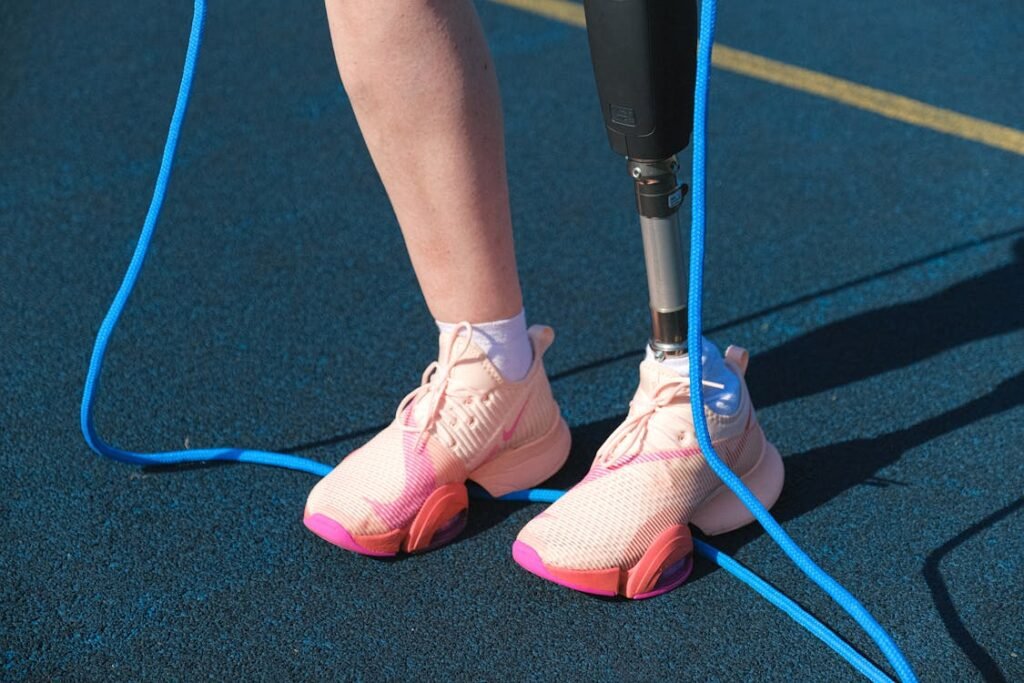
Key Components of Sports-Specific Gait Training for Amputee Runners
Personalized Assessment: Every Athlete Is Unique
Before any training begins, the first step is understanding the athlete — not just the prosthetic, but the whole person. Every amputee has a unique background. Some have been running for years before their amputation. Others are just discovering their athletic side. Their strength, balance, coordination, and confidence all play a role in how they move.
That’s why we start with a full-body assessment. This includes observing how you stand, how your body moves when walking and jogging, and how your muscles respond under pressure. We look at posture, stride length, hip and knee movement, trunk alignment, and how you shift weight between sides.
This helps us identify patterns that might not be obvious at first glance. Maybe your stride on the prosthetic side is shorter. Maybe your arms don’t swing evenly. Maybe your back is compensating for something in your hips. These are not flaws — they’re clues. Clues that tell us how to help your body move better, faster, and more naturally.
From there, we build a plan. One designed for your body, your sport, and your goals. Not based on textbook form, but real, human movement.
Strength Before Speed
It’s tempting to jump straight into running drills. But before speed comes strength. Without a strong foundation, fast movement can cause injury. In sports-specific gait training, we first make sure your body has the stability and power to support running.
We start by focusing on core stability. The core holds your body upright and helps control rotation. It keeps your hips level, your shoulders relaxed, and your movements efficient. Without it, even the best prosthetic can’t do its job well.
Then we work on hip strength. For amputees, the hips often do extra work to lift and swing the prosthesis. This requires strong glutes, balanced flexibility, and proper activation. If one side is weaker, we train it gently but consistently. When both hips work equally, running becomes smoother, faster, and less tiring.
We also focus on single-leg stability — the ability to balance and control movement while standing or hopping on one leg. This improves your push-off, landing, and confidence on uneven ground. When your legs are strong, stable, and trained to work together, everything else becomes easier.
Drills That Reinforce Rhythm and Form
Once the body is strong enough to support movement, we begin working on rhythm. Running is a repeated pattern — a rhythm of steps, breaths, and arm swings that must stay in sync. For amputee athletes, that rhythm can be disrupted by hesitation, uneven stride timing, or discomfort with the prosthetic.
That’s why we start with drills that rebuild this rhythm from the ground up.
For example, marching drills help you learn to lift the knee evenly on both sides. They teach your body how to push, lift, and land without leaning or twisting. Skipping drills reinforce timing, spring, and stride balance. Arm swing drills improve shoulder alignment and breathing rhythm.
We go slow. We break things down. We make sure each part of the motion is solid before putting them together. We don’t rush. Because once rhythm is locked in, speed and power come naturally.
And always, we watch how the prosthetic is responding. Is it flexing the way it should? Is it returning energy with each push-off? Is it aligned properly with your body? If not, we adjust. That’s the beauty of working with a custom-fit team — your training and your equipment evolve together.
Surface Matters: Training for Real-World Terrain
Running on a treadmill is different from running on grass, track, or pavement. Your feet hit the ground differently. The surface responds differently. For amputee athletes, these changes matter even more.
That’s why sports-specific gait training happens in varied settings. We want your body — and your prosthetic — to get used to different types of ground. Grass teaches you how to adjust stride and balance. Tracks help with speed and rhythm. Pavement builds durability and confidence in everyday settings.
We also train on slopes and curves. Most real-world environments are not flat. Learning to adjust your gait slightly, without losing form, is a skill. And like any skill, it needs to be practiced.
We focus on foot placement, how your prosthesis responds to pressure changes, and how your upper body helps you stay aligned when the ground shifts. Over time, this builds adaptability — a key part of confidence during any kind of run.
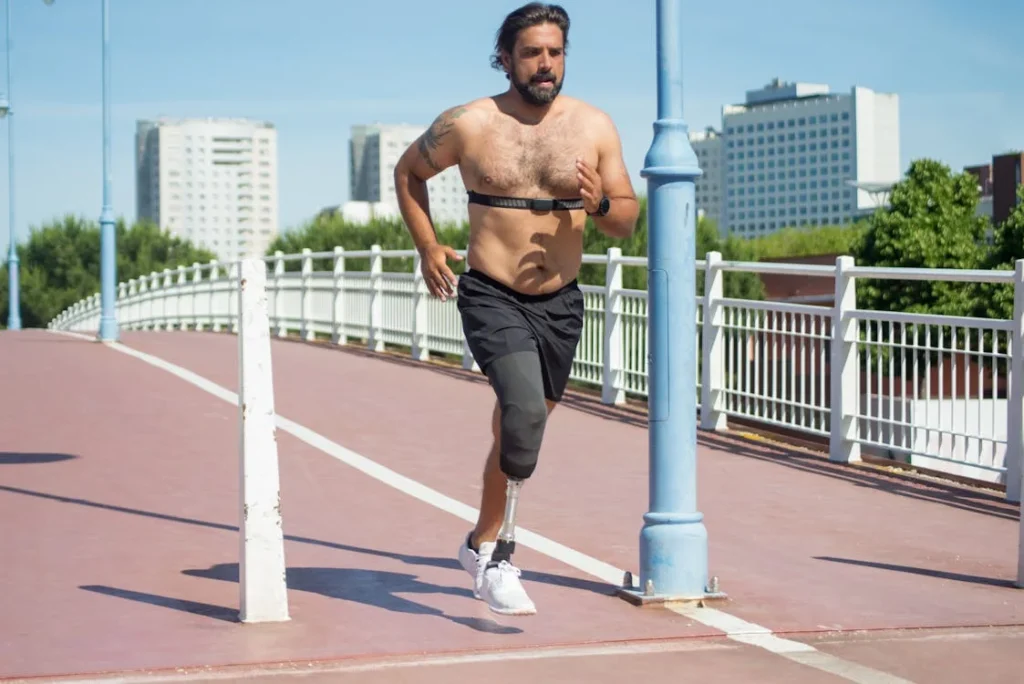
Adapting Gait Training to Competitive Sports and High-Performance Goals
From Basic Movement to Athletic Performance
Once the basics of balance, strength, and rhythm are in place, it’s time to shift gears. This is the stage where we transition from movement for comfort to movement for competition. Whether it’s track and field, marathon running, or team sports like football or basketball, every athletic pursuit places different demands on the body — and on the prosthesis.
At this level, the focus of gait training changes. It’s no longer just about walking or jogging evenly. It’s about precision, speed, reaction, and recovery. Training becomes more intense and more focused on sport-specific needs. Each drill, each run, each movement is tied to performance.
For runners, this means refining cadence and stride length to match race goals. It means learning how to start explosively off the line, how to shift gears mid-run, and how to finish strong. For team athletes, it may involve quick changes in direction, acceleration from a standstill, or short bursts of speed under pressure.
What doesn’t change is the attention to form. Even at high intensity, the foundation built earlier — symmetry, core control, hip strength — remains essential. Without it, performance suffers. With it, every movement becomes sharper, more confident, and more powerful.
Managing Fatigue and Maintaining Form
In the middle of a race or a tough training session, fatigue sets in. Muscles start to tire. Breathing gets heavier. Focus begins to slip. And this is where bad habits can creep back in. Even the best-trained athletes can revert to poor form when they’re tired.
That’s why a key part of sports-specific gait training is learning how to maintain your movement quality under fatigue. This isn’t about pushing through pain or ignoring discomfort. It’s about building awareness — noticing the first signs of collapse in form and knowing how to correct them in real time.
We teach cues you can repeat to yourself: “Stand tall.” “Drive the knee.” “Push through the ground.” These short, simple reminders help bring your mind back to proper mechanics even when your body is feeling the pressure.
Training also includes short recovery periods, teaching your body how to reset. In a race or competition, you may not get to stop, but you can still regain control. A slight change in breathing rhythm, a focus on arm swing, or a moment of mental focus can help bring your body back into alignment — even in the heat of the moment.
Technology in Gait Training: Video Feedback and Sensors
We live in a time where technology can support better movement in powerful ways. One of the most effective tools we use at Robobionics is video feedback. A slow-motion clip of a sprint or stride shows what the eyes can’t catch in real time. It reveals how the prosthetic is landing. Whether the hips are stable. Whether the shoulders are over-rotating. All these things, when seen clearly, become easier to fix.
We also use wearable sensors that track stride length, foot pressure, and symmetry. These provide hard data that can guide training decisions. They show whether your gait is consistent, whether fatigue is affecting one side more than the other, and where adjustments are needed.
This kind of feedback removes guesswork. It turns vague feelings into measurable results. And it gives athletes — especially amputees — a clearer understanding of their body’s performance. With this information, progress becomes faster, safer, and more confident.
The Role of Recovery in Athletic Gait
After intense training or competition, the body needs time to rebuild. For runners and active amputees, recovery is not just about rest. It’s also about maintaining alignment and mobility during downtime.
Post-run stretching, light movement, and occasional soft tissue work are all part of a balanced training program. We also focus on restoring symmetry after demanding efforts. For example, if one side of your body did more work during a sprint, recovery might include extra attention to the other side.
We also emphasize the importance of checking the prosthesis after hard use. Heat, sweat, and impact can change how it fits or functions. Even a small shift can affect gait. Regular adjustments, maintenance, and comfort checks help keep the equipment in sync with your body.
When recovery is respected, training becomes sustainable. And sustainable training leads to long-term performance without setbacks.
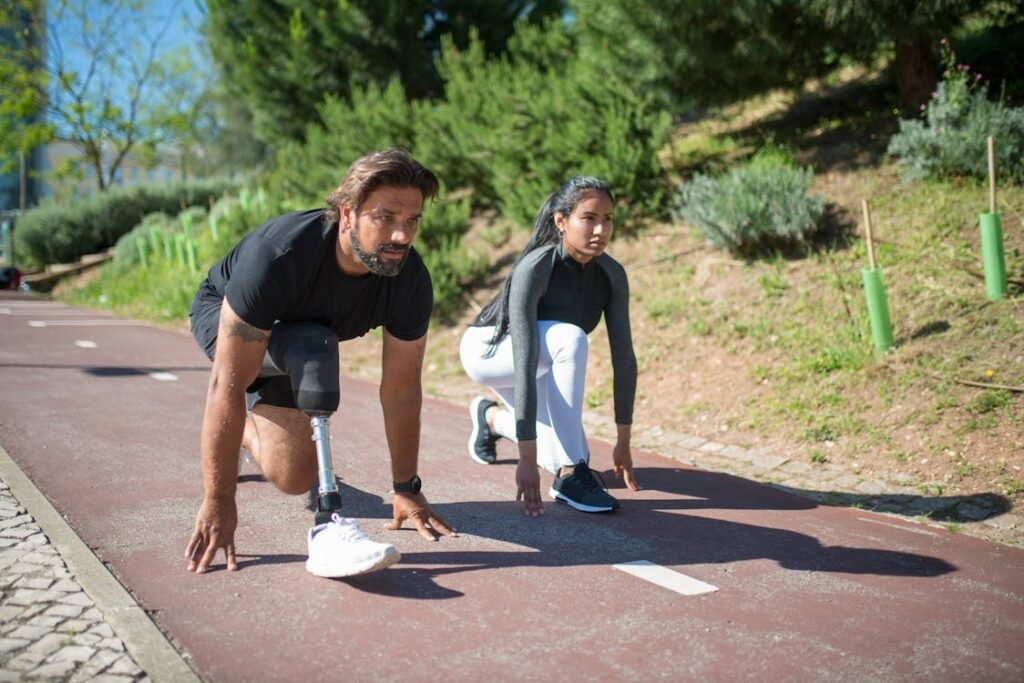
The Mental Mechanics of Running: Confidence, Focus, and Neuroplasticity
Why the Mind is a Core Part of Gait Training
Running is deeply physical, but every movement starts with the brain. It’s the control center for everything — timing, coordination, rhythm, and reaction. For active amputees, the brain has had to rewire how it communicates with the body. This neuroplasticity — the brain’s ability to adapt — is incredibly powerful, but it also requires training.
After an amputation, or even after receiving a new prosthetic limb, the brain has to learn a new way to move. It must send new signals, adjust for the feedback it receives from the prosthesis, and build trust in the body’s ability again. That trust doesn’t come automatically. It must be earned through experience — and that’s where the mental side of gait training begins.
When we coach amputee runners, we’re not just watching their feet. We’re watching their eyes, their reactions, their breathing — the subtle signals that tell us what they’re thinking. Do they hesitate before pushing off? Do they look down with every step? Are they holding tension in their shoulders? These are signs of doubt, and they matter as much as muscle strength.
Building Confidence Through Controlled Challenge
Confidence isn’t built by telling someone “you can do this.” It’s built by helping them prove it to themselves. That’s why we use graded challenges in gait training — small, doable tasks that stretch comfort zones just enough.
One day, it might be running 10 meters without looking down. Another, it might be performing a drill at half-speed with full posture focus. Over time, these small wins add up. The body learns the motion, but the brain learns something more important: I can trust this movement. I am in control.
This confidence reduces hesitation, smooths transitions, and helps athletes move more freely. It also helps prevent injury. When your mind hesitates, your body often compensates — and that’s when form breaks down. By reinforcing confidence, we reduce those risky moments of uncertainty.
Training the Brain to Move Efficiently
The brain wants to be efficient. When it finds a movement that works, it tends to repeat it. That’s good — unless that movement is unbalanced or awkward. For amputee runners, this happens more often than you’d think. A protective gait (where the athlete favors one side) might develop as a short-term solution, but it becomes a long-term habit if not corrected.
This is where neuroplastic training drills come in. These aren’t just physical exercises — they are coordination tasks that teach the brain and body to sync. Drills that combine balance, movement, and rhythm force the brain to engage more actively. They keep both sides of the body involved. They also reinforce symmetry by requiring focus on equal performance from both limbs.
Even something as simple as mirror running — running beside a mirror to watch and self-correct — becomes a powerful neurological tool. Visual feedback plus real-time action rewires the brain much faster than instruction alone.
Mindfulness and Breath: Tools for Better Control
Most athletes don’t think about breathing until they’re out of it. But conscious breathing is one of the best tools for improving rhythm and staying grounded in the moment. It directly impacts gait by controlling oxygen flow, posture, and core engagement.
Mindful breathwork is often included in our gait training sessions. It helps amputees get back in touch with their bodies. It quiets mental noise and enhances focus. When you breathe with intention, you move with intention.
This mental focus also helps prevent overthinking. One common issue for new amputee runners is mental overload — thinking too hard about every part of their movement. That can create stiffness and slow reaction times. Through mindfulness, we help athletes let go of that clutter and return to fluid, natural motion.
Visualization and Mental Rehearsal
Elite athletes often use visualization before a race — mentally rehearsing each part of their performance. For amputee runners, this practice is just as valuable, if not more.
We teach runners to close their eyes and picture themselves running smoothly, confidently, powerfully. They visualize the rhythm of their stride, the alignment of their body, the feel of the prosthetic working in harmony with their muscles.
The brain doesn’t fully distinguish between imagined and real movement. So this mental practice helps reinforce form, reduce anxiety, and increase readiness. When it comes time to run, the body already “knows” what to do — because it’s done it before in the mind.
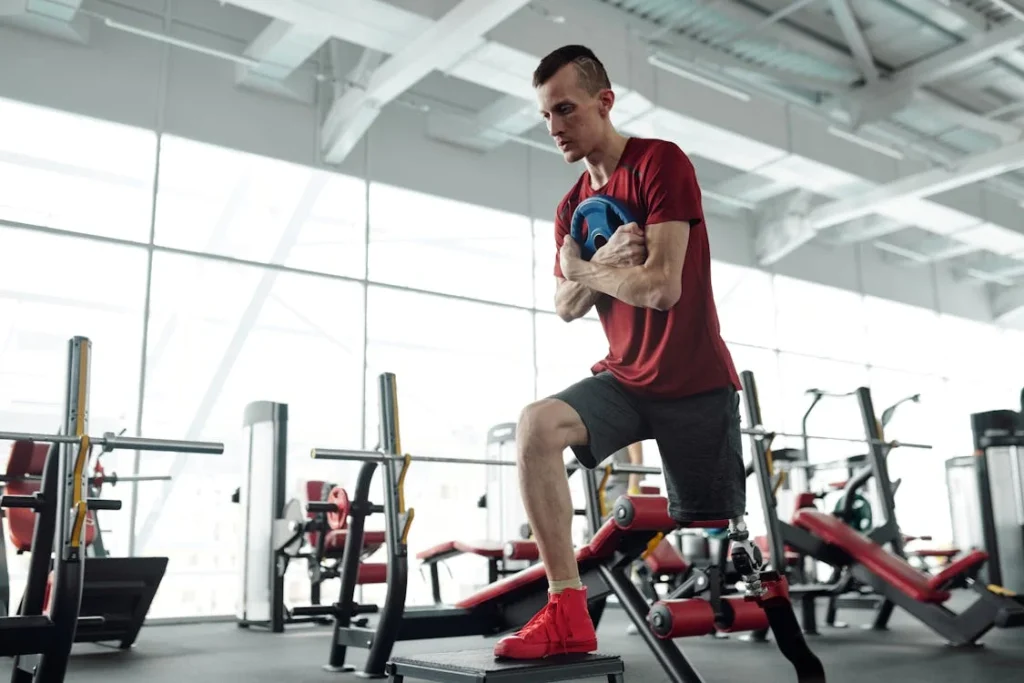
Integrating the Prosthesis Into the Athlete’s Identity and Lifestyle
Why the Relationship With the Prosthesis Matters
To most people, a prosthetic limb might look like a piece of equipment. But for an amputee — especially an active one — it’s much more than that. It’s not just a tool; it’s a part of how they move, perform, and express themselves physically. It becomes part of who they are.
But that relationship doesn’t happen overnight. In fact, one of the biggest obstacles to effective gait training and athletic performance isn’t physical — it’s emotional. If an athlete doesn’t feel connected to their prosthesis, they often hold back. They test it instead of trusting it. They move around it instead of through it.
This hesitation shows up in their stride — short steps, uneven loading, cautious turns. It shows up in their posture — tense shoulders, turned-out feet, guarded arms. And over time, it can lead to frustration and a plateau in progress.
At Robobionics, we’ve learned that high-performance gait training must also include helping the athlete own their prosthesis — not just use it. It should feel like an extension of their body, not an accessory. That mindset shift can change everything.
Custom Fit Is Just the Beginning
Fitting a prosthetic limb isn’t a one-time task. Just like a pair of running shoes, it must match the individual’s activity level, stride, and personal preferences. For athletes, this becomes even more detailed — the angle of the socket, the stiffness of the blade, the way the foot absorbs impact, and even how the knee responds under pressure.
But even with a perfect fit, the athlete has to feel ownership over the device. That means being part of the design process, testing settings, giving feedback, and learning how each small tweak changes the way they move.
When they understand their prosthesis — how it works, how to adjust it, and how to push its limits — they become more than users. They become operators. Confident, in control, and completely in tune with the technology that’s helping them perform.
This also builds trust. The athlete stops doubting whether the limb can handle sharp turns or fast sprints. They stop thinking of it as “the leg” and start thinking of it as my leg. That mental shift leads to more natural, powerful movement.
Creating a Daily Life That Reinforces Athletic Gait
The way a person moves during training isn’t isolated. It’s shaped by how they move in their daily life. That’s why sports-specific gait training often includes guidance beyond the track or the field.
If someone uses perfect form during drills but limps around their home or favors one side during everyday walking, those habits will creep back into their athletic performance. Gait is built over 24 hours — not just during a one-hour session.
We teach athletes how to carry the lessons of training into their routine — how to move evenly while grocery shopping, how to climb stairs with balance, how to stand for long periods without shifting all weight to one side. These moments reinforce the symmetry and control developed in training.
The more your body moves with athletic quality in everyday settings, the more automatic that form becomes in sports.
Personal Expression Through Movement
Running isn’t just function. It’s freedom. It’s flow. For many amputees, regaining that ability feels like getting a part of themselves back. But the goal shouldn’t just be to move well. It should be to move freely — in a way that feels like you.
That’s why advanced gait training often opens up room for personal expression. Some runners favor a compact stride, others move with long, elastic energy. Some athletes move like dancers, others like fighters. We don’t erase these qualities — we sharpen them.
The prosthesis, when aligned and integrated properly, should support your movement style — not someone else’s. And that style becomes part of your identity as an athlete. Just like any other athlete has their own way of moving, so should amputee runners.
This is where confidence reaches its peak. When you feel like yourself in motion — not just balanced, but bold — gait training has done its deeper work. It’s no longer about recovery or correction. It’s about performance and ownership.
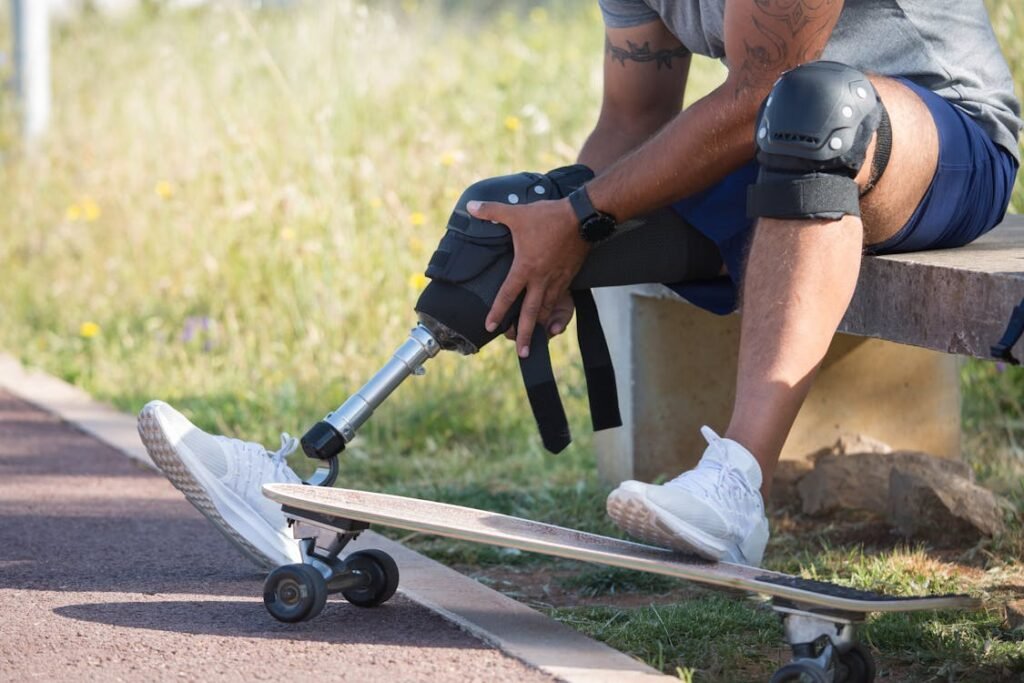
Community, Representation, and the Cultural Impact of Amputee Athletes in Sport
Running Isn’t Just Personal — It’s Political, Cultural, and Inspirational
When an amputee athlete steps onto a track, they’re not just competing. They’re breaking barriers. They’re challenging old assumptions about what a body can or cannot do. Every stride, every finish line crossed, becomes a symbol of possibility — not just for themselves, but for everyone watching.
This is why sports-specific gait training carries more weight than simply preparing for performance. It prepares the athlete to step into a much larger role — one of visibility, leadership, and inspiration. And that role brings its own challenges and responsibilities.
Many amputees, especially in India, have grown up with limited access to inclusive sports environments. Athletic spaces often lack adaptive equipment, specialized coaching, or even open-minded competition categories. As a result, many talented individuals never even consider running as an option — not because they aren’t capable, but because no one told them they were.
So when an active amputee decides to train seriously, to run competitively, to move with purpose — they’re opening doors. They’re showing the next generation that sport doesn’t belong only to the able-bodied. It belongs to anyone willing to train, sweat, and show up with courage.
At Robobionics, we believe this representation matters as much as training plans and prosthetic fit. Because when more amputees are seen running, competing, and winning, the culture shifts. The space becomes more inclusive. The expectations change.
Creating Access to Elite Training for All
For many amputee athletes, one of the biggest barriers is not motivation — it’s access. High-quality sports training, custom prosthetics, and expert gait coaching are often limited to large cities or elite institutions. That leaves countless individuals in smaller towns and villages without a clear path to pursue sport seriously.
This lack of access shapes how people view themselves. If no one around you is training at a high level, it’s hard to imagine that you could. If no coaches understand prosthetic use, it’s hard to get advice that helps. And if local sports events don’t welcome amputee competitors, it’s hard to feel like you belong on the field at all.
That’s why part of the solution must go beyond individual training. It has to involve community outreach, education for coaches, development of local adaptive sports programs, and public support. When a runner from a rural background receives the same level of training and technology as someone in a metro — that’s when change becomes real.
At Robobionics, we’ve worked with schools, clinics, and NGOs to help bring professional-grade support to more athletes. Because we know that talent is everywhere — it just needs the right chance to rise.
The Power of Role Models
Representation isn’t just about showing what’s possible — it’s about building a chain of belief. When a young child sees someone with a prosthetic leg competing at a high level, something shifts in their mind: “Maybe I can do that too.”
This is why sharing stories matters. Why amputee athletes who’ve been through the journey — from surgery to walking, walking to running, and running to racing — have the power to lead and inspire. These athletes don’t just show what can be done. They show how it’s done. They carry wisdom that can’t be taught in textbooks — only lived.
As more athletes rise through the ranks, their presence creates a ripple effect. It drives innovation in prosthetic design. It encourages sports bodies to create more inclusive categories. It changes how society talks about disability. And it pushes the boundaries of what’s possible — not just physically, but socially.
Gait training, then, becomes more than biomechanics. It becomes part of a movement. A movement toward visibility, equality, and shared pride in all forms of athletic excellence.
Redefining Normal, Redefining Victory
In a world that still often treats disability as limitation, every successful stride by an amputee runner rewrites the story. Gait training isn’t about “fixing” anything — it’s about refining human potential, no matter its shape.
And victory doesn’t always mean first place. Sometimes, it means completing a race without pain for the first time. Sometimes, it means feeling symmetrical after years of imbalance. Sometimes, it means being seen, being heard, and being respected as a full athlete.
These victories matter. They inspire. They transform. And they pave the way for others to dream bigger, run bolder, and move with pride — no matter the path beneath their feet.
Conclusion
Running is more than movement — it’s identity, freedom, and power. For amputee athletes, every step forward represents not only personal growth but a challenge to outdated limits. Sports-specific gait training isn’t just about mechanics; it’s about unlocking the full potential of body and mind. It builds strength, balance, confidence, and connection — both to the prosthesis and to the athlete within.
At Robobionics, we’ve seen the transformation that happens when precision engineering meets focused training and human will. Whether you’re preparing for your first race or aiming for the podium, your gait tells a story — one of resilience, reinvention, and relentless pursuit.
This journey isn’t about being “normal.” It’s about becoming powerful on your own terms. It’s about moving with intention, training with purpose, and showing the world what’s truly possible.
Your stride is your signature. Own it, sharpen it, and let it carry you beyond every expectation.



